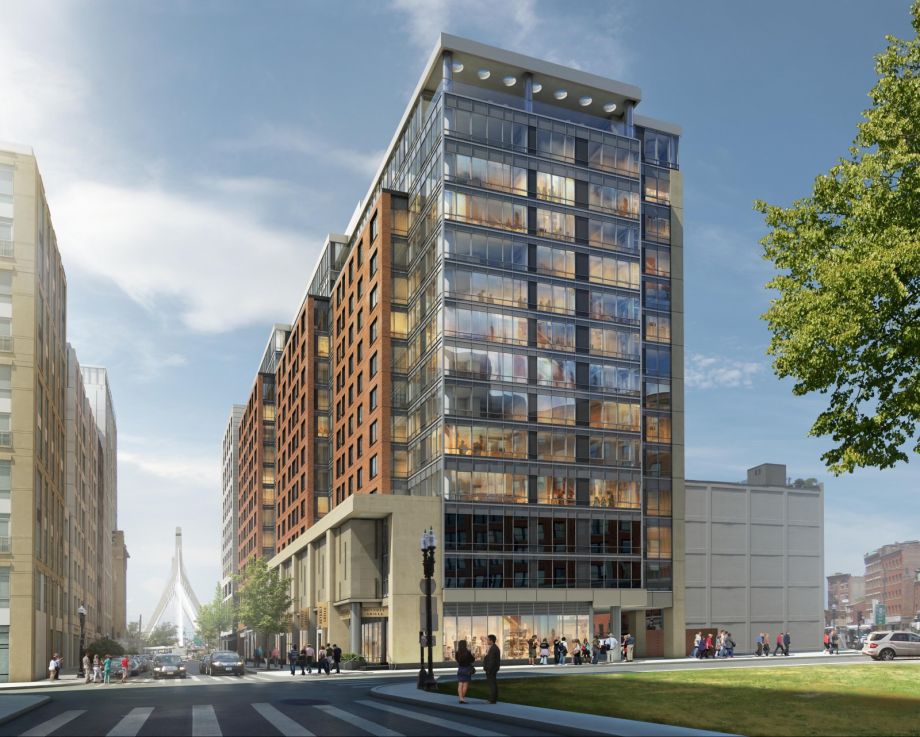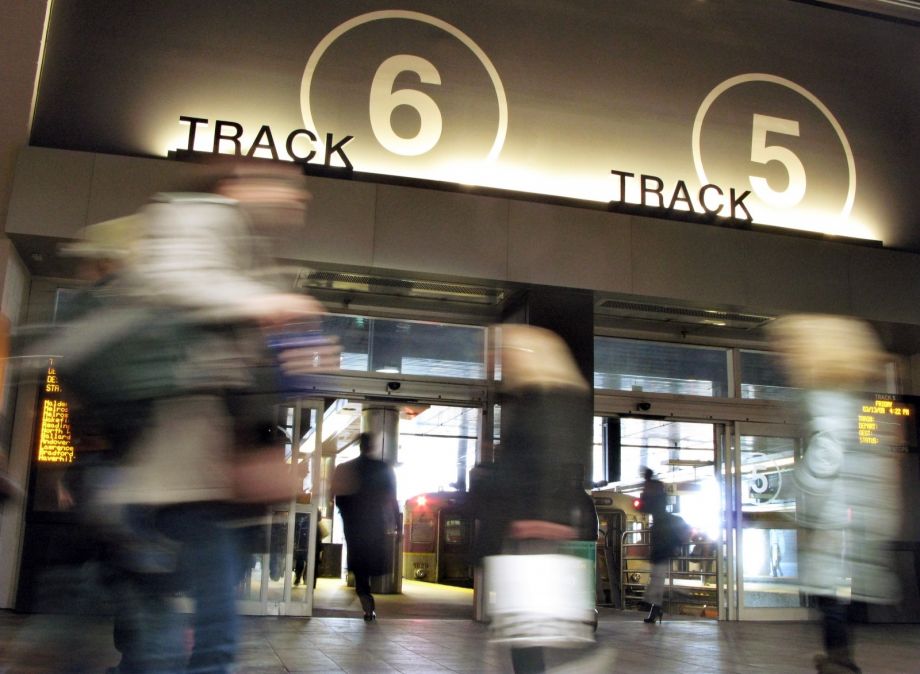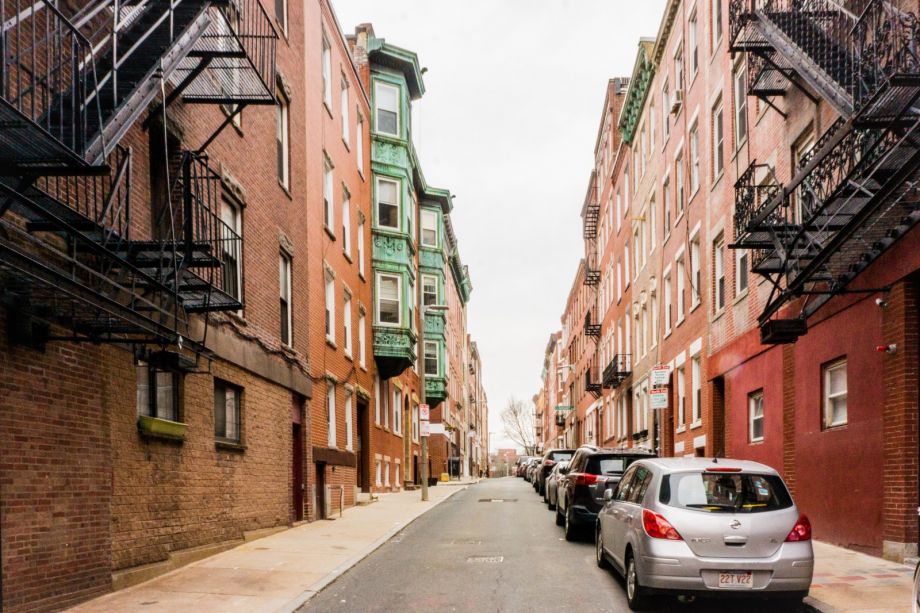Are You A Vanguard? Applications Now Open
Credit: Related Beal
This is your first of three free stories this month. Become a free or sustaining member to read unlimited articles, webinars and ebooks.
Become A MemberResidential development in the booming city of Boston is all about luxury these days, with the waterfront condominiums for sale on Lovejoy Wharf, at the mouth of the Charles River, among the latest examples. The 157 condos in a 15-story, red brick tower designed by Robert A.M. Stern Architects boast the usual bells and whistles — high-end kitchen, marble bathrooms, expansive views — while also offering access to a health club, rooftop terrace and 24-hour concierge. Prices start at $750,000 — for a studio.
The project’s developer, Related Beal, announced the start of sales earlier this year with a statement boasting of the project’s “fine finishes” and “state-of-the-art amenities.” But given the profusion of luxury towers in Boston, and the pace at which they are redefining neighborhoods in and around downtown, a far more remarkable achievement for Related, perhaps, is the glass-fronted apartment building the company is nearly finished building just across the street.
Called the Beverly, after the street it fronts, the 14-story structure will house 239 rental apartments, mainly studios and one- and two-bedrooms, but with 24 three-bedrooms as well. While these residences will not come equipped with gourmet kitchens and lavish baths, they will have something that is far more scarce in Boston: below-market rents.
The Beverly is the largest new construction of 100 percent income-restricted housing in downtown Boston in at least 25 years, making it a landmark even without any of the flourishes found across the road. All 14 floors are reserved for households with incomes between 30 percent of area median income (about $25,000 for a family of two) and 165 percent of area median income (about $136,500 for two). That means a studio will initially rent for as little as $480 and up to a high of about $2,900. A three-bedroom will start at around $1,200 (for a household at 50 percent of AMI) and top out at $4,300.
If those upper-end rents sound high, consider Boston’s staggering market realities. Just up the street at One Canal, another new apartment complex, market-rate studios start at about $2,500, while a three-bedroom starts at $6,370, according to Rent.com. Last year, the average rent for all new units downtown was $4,488, according to the city’s Department of Neighborhood Development.
In addition to income-restricted apartments, Related Beal’s complex will include a 220-room Courtyard Marriott and market-rate parking garage. About 10,000 square feet of ground-floor space will be dedicated to retail.
Scheduled to open early next year, the $230 million project was a cooperative undertaking, requiring the coordinated efforts of some 25 city, state and federal agencies to stitch together a complex web of financing involving low-income housing tax credits, bond financing, state and city housing trust fund contributions, and a property tax break.

A rendering of the exterior of the Beverly (Credit: Related Beal)
If the project barely moves the marker closer to Boston Mayor Marty Walsh’s goal to create at least 44,000 new affordable housing units in the city by 2030, based on population growth projections, it is progress nonetheless. And while this project was driven more by Related Beal’s expertise and initiative than by any one city policy, officials say at least one aspect of the deal may prove to be a model for getting more affordable housing built in the future. “It’s a shining example of how we can all work together,” says Jonathan Greeley, the director of development review for the Boston Planning & Development Agency (BPDA).
The Beverly is being built on one of the last state-owned parcels of land freed up by the so-called Big Dig, the massive (and colossally expensive) tunnel project that rerouted a downtown section of I-93 underground. The land takes up a city block at the northern fringe of downtown in the Bulfinch Triangle Historic District, part of a neighborhood now exploding with development. It is steps away from North Station — a major transit hub for Amtrak, commuter rail, subway and buses — as well as the TD Garden sports arena, home to the Celtics and Bruins. And it is close enough to Boston Harbor that the building’s upper floors will feature unobstructed water views.

Commuters scurry to their trains at North Station in Boston. (AP Photo/Elise Amendola)
Jay Walsh is the executive director of the Downtown North Association. He says that the rapidly growing neighborhood welcomes the new building. Poised to add thousands of new residents in the next five years, on top of the thousands they’ve welcomed in the last five, the neighborhood will benefit from having more affordable options added to the existing residential mix. “We’re fortunate we’re going to have a diversity of incomes within our small neighborhood, which will bring a diversity of other uses,” he says.
Even before Related Beal set its sights on the neighborhood, affordable housing was designated for the site. A previous development group had obtained authorization to build a hotel and rental development there, but the company’s plan called for only 15 income-restricted units onsite, and a separate $3.4 million contribution to an affordable housing fund established under the city’s inclusionary development policy. After the project stalled, Related Beal bought the development rights and began to rethink the plan.
While going 100 percent affordable would pose too much of a challenge for many developers, Related Beal, the Boston office of the Related Companies, a New York-based developer of multifamily housing with some 45,000 income-restricted units in its portfolio, “really has affordable housing in its DNA — we’re not afraid of it,” says Ted Lubitz, a vice president overseeing affordable housing projects. Knowing that Boston has a dire need for less expensive housing, and that the Walsh administration had made the creation of such housing a priority, Related took inspiration from a project they co-developed in Long Island City, Queens.
Called Hunter’s Point South, that project was built on city-owned land as part of the first phase of a 30-acre waterfront revitalization plan that will eventually include as many as 5,000 housing units. The first two towers included 925 units, all of which were income-restricted at several AMI levels. Setting a wide span of eligibility worked so well that the lottery for the units, held in 2014, drew more than 90,000 applicants, Lubitz notes.
“We chose to make this project 100 percent affordable because we saw the success there,” he says. “Boston has a lot of the same issues with housing supply and the cost of housing. We followed the same income-band model.”
When presented with the concept, the city quickly embraced it. “Once we heard it, we did everything we could to realize the vision,” says Sheila Dillon, the city’s chief of housing.
The city’s support alone wasn’t enough to make it happen, however. Matthew Kiefer, a Boston real estate lawyer, says this project benefited from a “rare alignment” of state and city subsidies, along with Related’s sophistication and ability to raise capital. “In my opinion,” Kiefer says, “it would be very hard to replicate. It’s not impossible, but all the planets only align every so often.”
Related Beal signed a $12.3 million, 99-year ground lease for the land, which is owned by the state Department of Transportation. The economics of the hotel/garage portion of the project are separate from the Beverly — each piece has to underwrite on its own, Lubitz says. But the hotel/garage portion assumes the cost of all of the land, which, in effect, reduces costs for the residential side, according to Dillon.
The city gave Related some flexibility on the parking, by allowing all of the garage spaces to be market rate and not requiring reserved spaces for the apartments. Demand for parking downtown is declining — it’s now roughly half a car per unit — and in this case, the city recognized that garage revenue helps drive the overall project’s feasibility, Greeley says. The city also factored in the building’s proximity to downtown and mass transit, and the likelihood that lower-income households in the Beverly would be less likely to own cars, he says. (Interestingly, Related also won city approval to build the Lovejoy condos without any associated parking at all.)
On the financing end, Related raised $14.6 million from a combination of federal and a state low-income housing tax credits. Another subsidy came through MassHousing, a quasipublic housing finance agency, which provided $3 million from the state’s Affordable Housing Trust Fund.
The BPDA facilitated the contribution of housing dollars collected under its inclusionary development policy. The policy allows developers to pay into the fund as an alternative to creating below-market-rate units within their projects. In 2015, $11 million contributed to the fund from a massive mixed-use development nearby at TD Garden went to the affordable units at the Beverly.
And perhaps even more crucially, the city signed off on a 23-year tax stabilization plan, authorized under a state program aimed at encouraging urban redevelopment. Instead of paying property taxes, the developer will pay a percentage of the residential project’s gross annual income, at a rate that steadily rises over time.
The state issued nearly $86 million in bond financing — $52 million of it tax exempt — for the apartments through Mass Development, its economic development authority. Wells Fargo facilitated the purchasing of the bonds. And Related Beal made a capital investment of roughly $52 million. The project broke ground in late December 2015.

The Beverly is located between the North End (above) and West End neighborhoods. (Photo by Akhil Dakinedi)
The Beverly’s per-unit cost came in at around $400,000 according to the city, which is fairly low for Boston. Related Beal acted as its own construction manager, which cut some costs, but another source of savings, Lubitz says, was the absence of excavation. Because the project is being built atop the freeway tunnel, an underground garage was out of the question. All the parking is aboveground.
The Beverly’s amenities, which include a fitness center, resident lounge and outdoor terrace, are on the 14th floor — where penthouses would normally be in a market-rate building. Residents logging miles on the treadmills will enjoy views of the harbor, downtown and the Rose Kennedy Greenway. A bike storage and dog spa are also onsite.
Lease applications for units will go out in July. A lottery will be held in September, with Boston residents receiving preference.
Competition for the lowest-priced units will likely be the most fierce. Just five units are available for households at 30 percent of AMI, and three for those at 40 percent. The units are fairly evenly distributed across the rest of the income bands, with the exception of a bulge of 70 units, more than half of which are one-bedrooms, at 140 percent of AMI, which Lubitz attributed to expected demand. Rents for those one-bedrooms will be about $2,500.
Some might argue that lowering rents for upper-income households is unnecessary and not doing much to aid those who are most stretched by housing costs. But Joe Kriesberg, president of the Massachusetts Association of Community Development Corporations, argues in favor of the approach. For one thing, he says, “the 165 percent of AMI unit isn’t displacing a 60 percent unit. It’s displacing a market-rate unit for somebody that makes $400,000 a year.”
In addition, he says, the rents will become increasingly affordable over time. (The income restrictions are in place for 50 years.) Rents will only increase as fast as AMI — “usually 1 or 2 percent above inflation annually, if we’re lucky” — which means they will rise at a more slow and steady pace than market rents.
The approach makes sense in a city with skyrocketing rents, Kriesberg says: “It’s essentially buying rent control. If we had done this in 1997, there’d be a whole bunch of apartments that would be a lot cheaper here today.”
Barry Bluestone, professor of public policy and urban affairs at Northeastern University and a senior fellow at the Boston Foundation, applauds the project for “breaking the traditional mold.” He cautions, however, that Boston will need “many, many more of these projects and other models to get anywhere near close to the amount of housing we’re going to need. By 2030, across Greater Boston, we’re going to need 160,000 units, and most of those are going to have to be affordable for working-income people. And we have very, very little new housing going up at that level.”
A Greater Boston Housing Report Card put out last year by the Dukakis Center and the Boston Foundation found that the percentage of construction permits issued annually by the city for affordable units has declined sharply in the last 20 years. Between 1996 and 2003, nearly 40 percent of all permits were for affordable units. Between 2004 and 2010, affordables accounted for about 25 percent. And from 2011 to 2016, the proportion shrank further to just 18 percent, an indicator “of the extreme difficulty of constructing housing units that can be profitably built and sold or rented at affordable prices,” the report states.
City housing officials are already looking for other opportunities to do projects with a financial structure similar to the Beverly’s, possibly in partnership with Related Beal. Lubitz says he is hopeful that the various stakeholders can again be brought together to get more housing built. “The tools we used are ones we hope can be applied to the next project,” he says.
Lisa Prevost is a New York City-area journalist specializing in housing and real estate development. She is the author of “Snob Zones: Fear, Prejudice and Real Estate” (Beacon Press, 2013), and a regular contributor to The New York Times.

20th Anniversary Solutions of the Year magazine